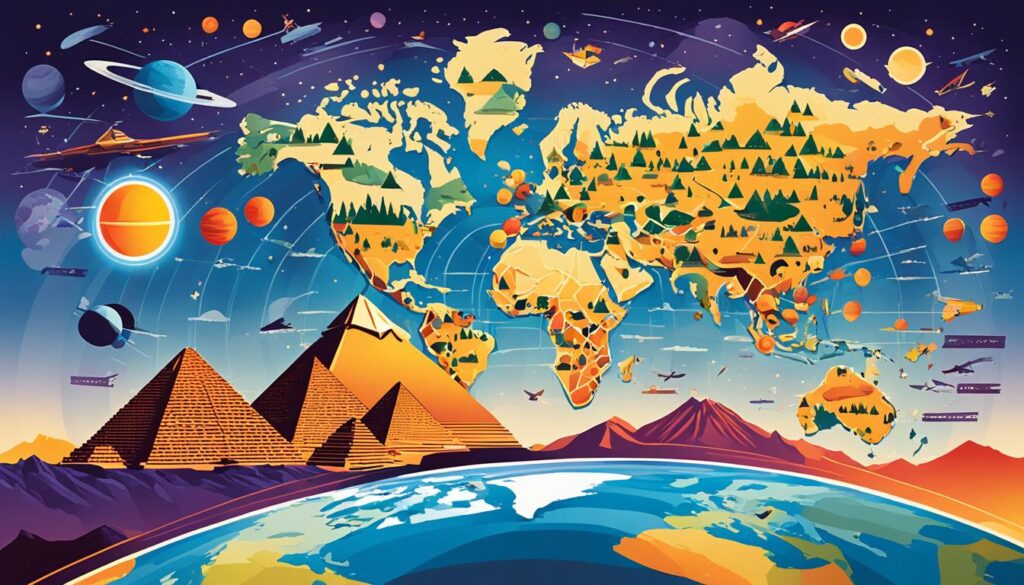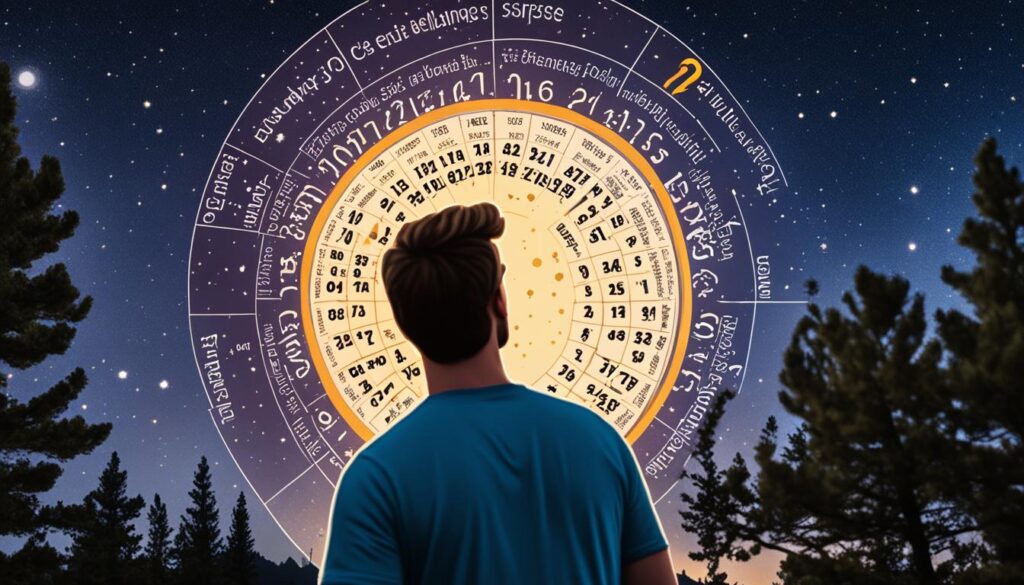Did you know there will be more than 10,000 eclipses during our lives? That’s amazing! You can see the sky’s beauty with both solar and lunar eclipses.
Eclipses have amazed people for hundreds of years. They’re both beautiful and mysterious. Have you thought about how many you’ll see?
Key Takeaways:
- There are over 10,000 eclipses during an average human’s life.
- Eclipses have amazed people for a very long time.
- Stay tuned to learn how many eclipses you might see.
The Wonders of Total Solar Eclipses: A Rare Spectacle
Total solar eclipses are awe-inspiring cosmic events. They captivate observers around the world.
The sheer magnitude and beauty make it remarkable. But what is a total solar eclipse?
What Defines a Total Solar Eclipse
A total solar eclipse happens when the Moon is between the Sun and Earth. It blocks the Sun’s light from reaching us.
This alignment creates darkness during the day. It reveals the Sun’s outer atmosphere, the corona.
A total solar eclipse completely covers the Sun. Observers in the path of totality see the Sun’s corona.
The Power of the Path of Totality
The path of totality is a narrow strip on Earth. Here, you can see the eclipse in full.
In this path, the eclipse is dramatic, with the Sun hidden by the Moon. Being in the path is a rare chance to feel the eclipse’s full power.
The length of totality can vary. It lasts from a few seconds to about 7 minutes and 30 seconds.
Viewing Eclipses Across the U.S.: A Historical Perspective
Many total solar eclipses have happened in the United States. The “Great American Eclipse” of August 21, 2017, is famous. It went from the west coast to the east coast.
The “Path of Totality Eclipse” of 1979 is another big one. It went through several states and parts of Canada. Those who saw it remember it well.

These historical eclipses remind us of their extraordinary nature. They inspire wonder in those who see them.
Now you know the wonders of total solar eclipses and the path of totality. Next, let’s see how often and where these amazing events happen.
Eclipses Across the Globe: More Frequent Than You Think
Eclipses happen all over the world. People from everywhere enjoy them. Some think eclipses rarely happen. But, they are more common than you might believe.
A solar or lunar eclipse happens often. People globally can see their beauty. Eclipses can happen a few times a year. Sometimes, there are many in one year.
Some places see eclipses more because of their spot on the globe. For example, areas near the equator see more eclipses. This is different from places near the poles.
Eclipses mean different things in many cultures. They have inspired stories and science through history. This makes eclipses even more exciting.
When you look at the sky for an eclipse, remember they are common. No matter where you are, you can enjoy these amazing events. They happen worldwide.
Eclipse Chasing: Maximizing Your Chances to Witness Solar Eclipses
Seeing a solar eclipse is unforgettable for sky watchers and astronomy lovers. To see this amazing event, knowing where eclipses happen often is key.
Planning trips to where solar eclipses happen a lot is called eclipse chasing. These places give you the best chance to see a total solar eclipse clearly.

Future total solar eclipses are something to look forward to. By keeping up with eclipse news, you can pick the best spots early. Finding out when and where the next total solar eclipses are is important. This way, you won’t miss these special moments.
Technology is super important for predicting eclipses. It helps astronomers and eclipse chasers know exactly where and when an eclipse will be. With apps and websites, technology gives helpful tips for your eclipse trips.
The Phenomena Surrounding Eclipses: Understanding the Science
Eclipses are more than just cool to watch. They teach us about science. We learn about science of eclipses by studying how things in space move. This helps us understand why they happen. We also learn from changes in temperature and shadow bands during eclipses.

During a solar eclipse, the moon gets between the sun and Earth. This casts a shadow on us. It happens because of the mechanics of eclipses. The way the moon and Earth move is key. Everything must line up just right for an eclipse to occur.
When the moon hides the sun, we can see amazing things. We can see the corona. It looks like a glowing ring around the dark moon. We can also see solar flares and prominences. These are big blasts of gas from the sun.
Eclipses have cool effects too. Right before and after an eclipse, we can see shadow bands. They are like light and shadow waves on the ground. Scientists think they are caused by the atmosphere and light bending.
Studying eclipse mechanics is exciting for scientists. They learn a lot by watching eclipses. This helps them understand how things in space work together.
| Eclipse Phenomena | Description |
|---|---|
| Corona | The sun’s outer atmosphere that appears as a glowing halo during a total solar eclipse. |
| Solar Flares | Eruptions of hot gas from the sun’s surface that can be observed during a total solar eclipse. |
| Shadow Bands | Faint, wavy lines of light and shadow that ripple across the ground before and after the total phase of a solar eclipse. |
How Many Eclipses Will You See in Your Lifetime?
Do you love watching eclipses? You might wonder how many you can see. Let’s figure out how many solar and lunar eclipses you might see. We will look at your birth year and some key factors.
Every person will see a different number of eclipses. How often and where you can see them varies. This depends on where you live and the eclipse type.
Here’s how to guess how many eclipses you might see:
- The Saros Cycle: This is about 18 years long. After this time, a similar eclipse happens again. This cycle is based on how the Sun, Earth, and Moon line up.
- Your Birth Year: Find the Saros series that started when you were born. This helps you know how many eclipses you might see.
- Geographical Location: Where you live affects how many eclipses you will see. Some places get more eclipses than others.
In this case, someone born in 2000 might see 29 eclipses. This includes both solar and lunar eclipses. Where you are can change this number.
Eclipses happen often. But, not all places on Earth can see them each time. Going to places where eclipses happen more can let you see more of them.
Knowing about eclipses helps you enjoy their mystery and beauty more. Now you might see how many eclipses you can watch.
Conclusion
Eclipses are amazing events that have amazed people all over the world. They happen at different times and have big meanings in many places.
Eclipses make us wonder because they look so cool. People have loved them for many years.
We learned a lot about how eclipses happen by studying science. They come with cool changes like temperature drops and shadow bands.
Eclipses are more than just pretty to look at. They help us learn about space too.
Maybe you’ve seen many eclipses or are waiting to see your first one. Either way, everyone gets excited about future ones.
Thanks to new technology, it’s easier to know when and where eclipses will happen. Some people even travel far to see them.
Eclipses show us how big and beautiful the universe is. Every eclipse is special, whether it’s a big solar eclipse or a small lunar one.
Always watch the sky for eclipses. They’re a great chance to see something awesome.
FAQ
How many eclipses will I see in my lifetime?
The number of eclipses you’ll see depends on a few things. These include when you were born and where you live. To guess how many, you can look at past eclipses and future forecasts. Some places see more eclipses than others.
What defines a total solar eclipse?
A total solar eclipse happens when the moon gets right between the sun and Earth. It makes a shadow on the Earth. During this time, the sun looks fully covered. You can see a dark path. This path is where you can best see the eclipse.
Why is the path of totality significant in a total solar eclipse?
The path of totality is very important. It’s where the eclipse looks its biggest and best. The moon covers the sun completely here. It gets dark, and you can see the sun’s outer ring. Seeing an eclipse here is a special experience.
Are there any notable total solar eclipses that have occurred in the United States?
Yes, the U.S. has seen big eclipses. One big one was the Great American Eclipse in 2017. It went from Oregon to South Carolina. Many people saw it. Eclipses like this have taught us a lot and are important in history.
How frequently do eclipses occur around the world?
Eclipses happen all over the world, not just in one place. They happen at different times. Some places see more eclipses than others. But all places can have them at some point.
Are there strategic locations around the world with a high eclipse frequency?
Yes, there are special places where eclipses happen a lot. People who love eclipses go to these places. Going to these spots can give you more chances to see eclipses. It’s a way to see more of these cool events.
When and where will future total solar eclipses occur?
Scientists can guess when and where we’ll see more eclipses. They use science to tell us dates and places. Knowing this, you can plan to see these amazing sights in different parts of the world.
How does technology play a role in predicting and planning for eclipses?
Technology helps a lot with eclipses. Scientists use smart tools to know when and where they’ll happen. Then, they share this info with everyone. This lets people plan to see eclipses and enjoy these special moments.
What is the science behind eclipses?
Eclipses are not just pretty. They can teach us about space stuff. By studying eclipses, we learn how the sun, moon, and Earth move. This helps us understand more about space.
Can the number of eclipses I witness in my lifetime be calculated?
Yes, you can figure out how many eclipses you might see. It looks at when you were born and other facts. By looking at past and future eclipses, you can make a good guess.
What are the key points covered in this article about eclipses?
This article talks about many things. Like how often eclipses happen, what a total eclipse is, and the path of totality. It also covers big eclipses in history, where to see them, and the science behind them. Plus, it talks about guessing how many you might see. It’s all about how amazing eclipses are.

